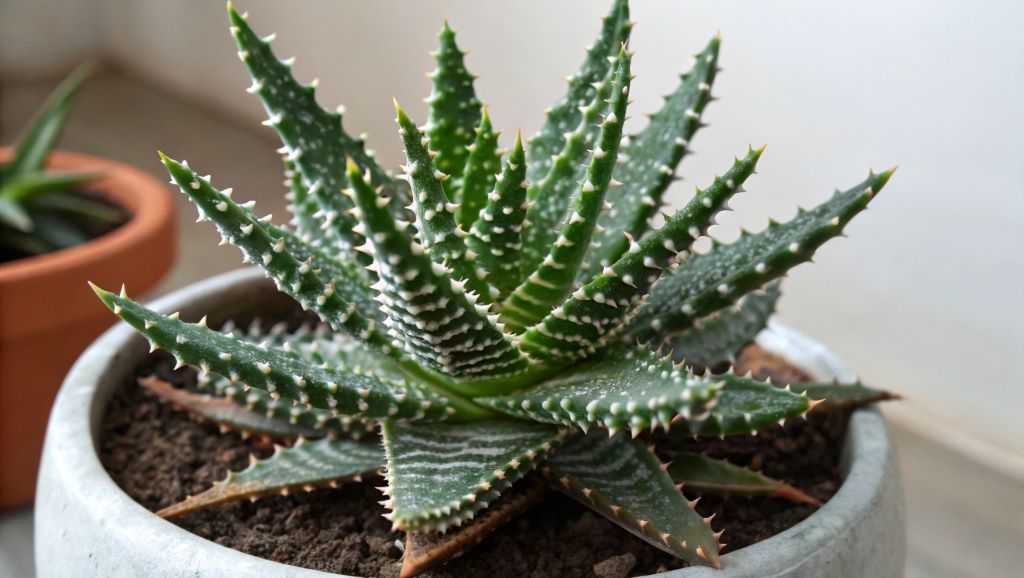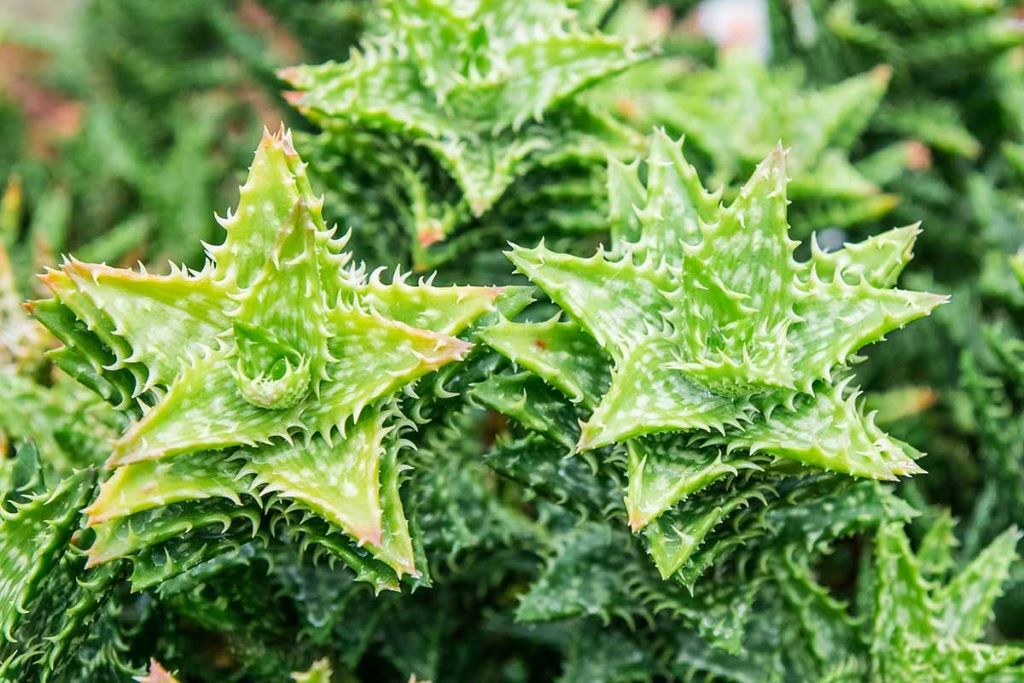
In the vast and varied world of succulents, the Tiger Tooth Aloe (Aloe juvenna) stands out with its undeniably charismatic appeal. Far from being just another green plant, this distinctive aloe, with its stacked rosettes and unique, serrated “teeth,” adds a touch of architectural drama and exotic allure to any indoor or outdoor space. Often mistaken for other spiky succulents, the Tiger Tooth Aloe is a true gem for both novice and experienced plant enthusiasts alike, offering remarkable resilience and a captivating aesthetic.
This comprehensive guide will delve deep into the fascinating world of Aloe juvenna, providing you with all the essential information to cultivate a thriving, beautiful specimen. We’ll explore its origins, unravel its care requirements, discuss common challenges and their solutions, and even touch upon its potential for propagation and ornamental uses. Get ready to discover why the Tiger Tooth Aloe might just be the next star of your plant collection!
The Allure of the Aloe juvenna: A Closer Look
Before we plunge into the practicalities of care, let’s take a moment to appreciate what makes the Tiger Tooth Aloe so special. Scientifically known as Aloe juvenna, it’s a member of the diverse Aloe genus, which includes the famous Aloe vera. However, Aloe juvenna distinguishes itself with its compact, upright growth habit, forming dense columns of triangular, fleshy leaves arranged in tight rosettes.
What truly gives this succulent its “tiger tooth” moniker are the small, soft, yet prominent white teeth-like margins along the edges of its vibrant green leaves. These “teeth” aren’t sharp or menacing, but rather add a playful texture and visual interest. When exposed to ample sunlight or cooler temperatures, the leaves can take on beautiful reddish-purple or coppery-bronze hues, intensifying their already striking appearance. Originating from the rocky terrains of Kenya and Tanzania, the Tiger Tooth Aloe is a testament to nature’s ability to create beauty in even the most arid environments, a characteristic that translates directly into its relatively low-maintenance needs.
Cultivating a Roaring Success: Essential Care Guidelines for Your Tiger Tooth Aloe
Caring for a Tiger Tooth Aloe is generally straightforward, making it an excellent choice for those new to succulents or anyone seeking a rewarding yet undemanding plant. Here’s a breakdown of the key factors for a flourishing Aloe juvenna:
-
Light: The Sunshine Secret
Like most succulents, the Tiger Tooth Aloe absolutely adores light. However, it’s crucial to distinguish between bright, indirect light and harsh, direct sun.
- Indoors: The ideal spot for your indoor Tiger Tooth Aloe is a south or east-facing window where it can receive several hours of bright, indirect sunlight daily. It will thrive in a well-lit room. While it can tolerate lower light conditions, you might notice its leaves becoming a bit “leggy” or stretched as it searches for more light, and its vibrant colors may not be as pronounced. Avoid prolonged exposure to intense, direct afternoon sun, especially through a window, as this can lead to sunburn, characterized by brown or reddish-brown leaf tips.
- Outdoors: In suitable climates (USDA Hardiness Zones 8b and above), Aloe juvenna can be grown outdoors. Here, it prefers full sun to partial shade. In hotter climates, providing some afternoon shade is advisable to prevent scorching. When happily stressed by ample light or cool temperatures, the creamy white spots on its leaves become more prominent, and the leaves themselves deepen to those desirable reddish-purple tones.
-
Watering Wisdom: Less is More
Overwatering is the single most common cause of succulent demise, and the Tiger Tooth Aloe is no exception. Remember its desert origins – it stores water in its fleshy leaves to survive dry spells.
- The “Soak and Dry” Method: The golden rule for watering your Tiger Tooth Aloe is to allow the soil to dry out completely between waterings. This typically means watering every 2-4 weeks, though this can vary significantly depending on your climate, humidity, pot size, and the time of year.
- Checking Soil Moisture: Before watering, stick your finger about an inch or two into the soil. If it feels dry to the touch, it’s time to water. If there’s still any dampness, wait a few more days.
- Thorough Watering and Drainage: When you do water, water thoroughly until you see water draining from the bottom of the pot. Crucially, ensure that no standing water remains in the saucer beneath the pot, as this can quickly lead to root rot. Good drainage is paramount!
- Seasonal Adjustments: Reduce watering significantly during the cooler, darker winter months when the plant’s growth slows down and it enters a semi-dormant state.
-
Soil: The Foundation of Health
Well-draining soil is non-negotiable for the Tiger Tooth Aloe. It mimics its natural habitat, preventing waterlogging and promoting healthy root development.
- Succulent/Cactus Mix: The easiest option is to use a pre-formulated succulent and cactus potting mix, readily available at garden centers.
- DIY Mix: You can also create your own by amending regular potting soil with gritty materials like perlite, pumice, coarse sand, or small gravel. A good ratio is typically 1 part potting soil to 1-2 parts drainage material.
- Neutral to Slightly Alkaline: Tiger Tooth Aloe prefers a neutral to slightly alkaline soil pH.
-
Temperature and Humidity: A Warm Embrace
Aloe juvenna thrives in warm, average room temperatures.
- Temperature Range: Ideal temperatures for indoor cultivation range from 60°F to 80°F (16°C to 27°C). Protect it from cold drafts and temperatures below 40°F (4°C), which can cause damage.
- Humidity: Being a succulent from arid regions, it prefers low to moderate humidity levels. Typical indoor household humidity is usually sufficient. Avoid excessively humid environments.
-
Fertilization: A Light Touch
Tiger Tooth Aloes are not heavy feeders and generally do not require frequent fertilization.
- Minimal Feeding: For indoor plants, feeding once or twice during the active growing season (spring and summer) with a diluted succulent-specific fertilizer is usually sufficient.
- Outdoor Plants: Outdoor plants often don’t need any additional fertilization if grown in suitable soil.
- Avoid Winter Feeding: Do not fertilize during the dormant winter months.
-
Potting and Repotting: Room to Roam
Tiger Tooth Aloes are slow growers, so they don’t need frequent repotting.
- Drainage Holes: Always choose a pot with drainage holes to prevent water from accumulating at the bottom. Terracotta pots are often recommended as they are porous and help wick away excess moisture.
- Repotting Frequency: Repot every 2-3 years, or when the plant becomes root-bound, meaning its roots have filled the pot and are circling the drainage holes.
- Pot Size: When repotting, choose a pot that is only one or two inches larger in diameter than the previous one. Too large a pot can hold too much moisture, increasing the risk of root rot.
- Fresh Soil: Always use fresh, well-draining succulent potting mix when repotting.
The Beauty of Bloom: Does Tiger Tooth Aloe Flower?
While primarily grown for its unique foliage, the Tiger Tooth Aloe can produce delicate, tubular flowers. These typically emerge on tall stalks in shades of orange, red, or yellow, usually in mid to late summer, though some sources note winter blooms as well.
- Indoor Blooms: Flowering is less common for indoor plants compared to those grown outdoors in ideal conditions. Adequate sunlight and consistent care are key to encouraging blooms indoors.
- Outdoor Blooms: Outdoor specimens, especially those in sunny, warm climates, are more likely to flower, attracting hummingbirds to your garden.
Propagation: Expanding Your Tiger Tooth Collection

Propagating Aloe juvenna is a rewarding process, allowing you to multiply your collection or share with friends. The most common and successful methods include:
- Offsets (Pups): This is the easiest and most reliable method. Tiger Tooth Aloes naturally produce small “pups” or offsets around the base of the parent plant.
- Carefully remove the parent plant from its pot and gently brush away the soil to expose the roots.
- Identify offsets that have developed their own root system.
- Gently separate them from the parent plant, ensuring each pup has some roots attached.
- Allow the cut surfaces of the pups to “callous over” for a day or two in a dry, shaded spot. This helps prevent rot.
- Plant the calloused pups in small pots filled with well-draining succulent soil and water lightly.
- Place them in bright, indirect light and water sparingly until they establish.
- Leaf Cuttings (Less Common but Possible): While not as reliable as offsets, you can attempt propagation from leaf cuttings.
- Select a healthy, mature leaf and cut it cleanly from the base of the plant.
- Allow the cut end to callous over for several days, or even a week, until it’s dry and firm.
- Place the calloused end into well-draining succulent soil, burying about an inch of the leaf.
- Water very sparingly, only when the soil is completely dry. This method requires patience, as rooting can take several weeks or even months.
Common Challenges and Solutions: Keeping Your Tiger Tooth Roaring
Even with relatively easy care, a few common issues can arise with Tiger Tooth Aloes. Knowing what to look for and how to respond can save your plant.
- Mushy, Yellowing Leaves / Root Rot: This is almost always a sign of overwatering.
- Solution: Immediately stop watering. If severe, gently remove the plant from its pot, inspect the roots, and trim away any brown, mushy, or rotten sections with sterilized scissors. Allow the roots to air dry for a day before repotting in fresh, dry, well-draining soil. Ensure your pot has adequate drainage holes.
- Leggy Growth / Fading Color: This indicates insufficient light.
- Solution: Move your plant to a brighter location with more indirect sunlight. If growing indoors, consider supplementing with a grow light, especially during winter.
- Brown or Reddish-Brown Leaf Tips/Sunburn: Too much direct, intense sunlight.
- Solution: Relocate your plant to a spot with bright, indirect light. While cosmetic, sunburn doesn’t usually harm the plant, but the discolored leaves won’t revert to green.
- Dry, Crispy Leaves / Underwatering: While uncommon, extreme underwatering can cause leaves to shrivel and become crispy.
- Solution: Give your plant a thorough, deep watering. Ensure the water drains completely.
- Pests: Tiger Tooth Aloes are relatively pest-resistant, but occasionally succumb to common succulent pests like mealybugs or spider mites.
- Solution: Inspect your plant regularly. For minor infestations, wipe affected areas with a cotton swab dipped in rubbing alcohol. For more severe cases, use an insecticidal soap specifically formulated for succulents, following product instructions carefully.
Beyond the Basics: Design Ideas and Medicinal Notes
While the Tiger Tooth Aloe isn’t generally used for the same extensive medicinal purposes as Aloe vera (which has a larger, more gel-filled leaf), some sources suggest it shares some general aloe properties for minor skin irritations. However, its primary value lies in its ornamental appeal.
Its unique form makes it a fantastic addition to various design schemes:
- Container Plantings: Its upright, columnar growth habit makes it a perfect “thriller” in succulent container arrangements, providing vertical interest.
- Rock Gardens: In suitable climates, it excels in rock gardens, mimicking its natural, rocky habitat.
- Indoor Accents: Place it on windowsills, bookshelves, or desks to add a distinctive, architectural touch to your interior decor. Its compact size makes it suitable for smaller spaces.
- Xeriscaping: For water-wise landscaping, it’s an excellent choice due to its drought tolerance.
Best Apartment Plant: Low-Maintenance, Air-Purifying Indoor Greenery Guide
Conclusion: Embrace the Spiky Beauty
The Tiger Tooth Aloe, or Aloe juvenna, is more than just a pretty face in the succulent world. Its distinctive appearance, coupled with its forgiving nature and relatively low maintenance requirements, makes it a true champion for plant lovers of all experience levels. By understanding its needs for ample light, careful watering, and well-draining soil, you can ensure your Tiger Tooth Aloe thrives, bringing a touch of the wild and exotic to your home or garden. So, go ahead, embrace the spiky charm of this magnificent succulent, and watch it become a captivating focal point in your plant collection!
Read More:
12 Easy Steps to Grow Your Own Flavorful Bubble Gum Plant at Home





